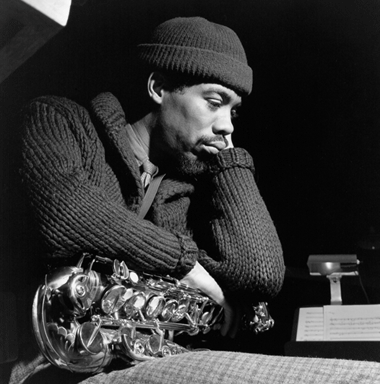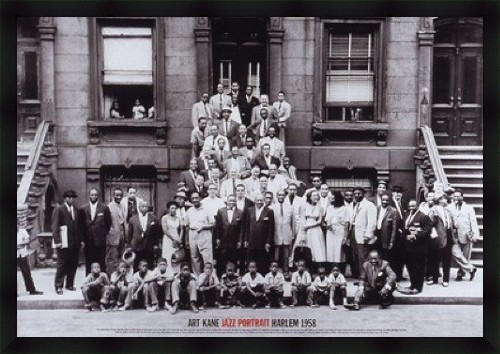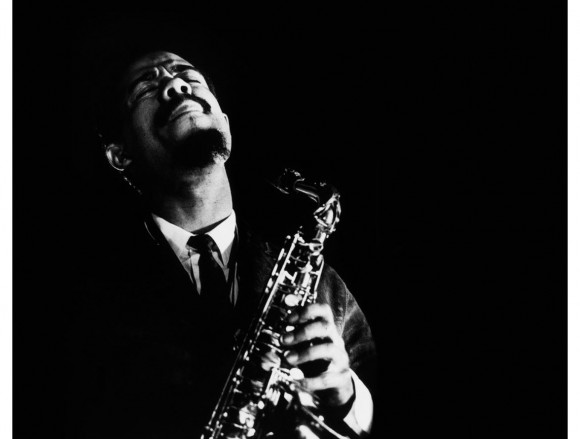Question: What’s it all about?
Answer: I don’t know.
But I do know a few things.
I know some of the things that make me tick.
Even though I write (for fun, for real and forever), I would still say that music has always been the central element of my existence. Or the elemental center. Writing is a compulsion, a hobby, a skill, a craft, an obsession, a mystery and at times a burden. Music simply is. For just about anyone, all you need is an ear (or two); that is all that’s required for it to work its magic. But, as many people come to realize, if you approach it with your mind, and your heart and, eventually (inevitably) your soul, it is capable of making you aware of other worlds, it can help you achieve the satisfaction material possessions are intended to inspire, it will help you feel the feelings drugs are designed to approximate. Et cetera.
I know that jazz music has made my life approximately a million times more satisfying and enriching than it would have been had I never been fortunate enough to discover, study and savor it.
During the last 4-5 years, I’ve had (or taken) the opportunity to write in some detail about Charles Mingus, John Coltrane, Miles Davis, Thelonious Monk, Freddie Hubbard, Ornette Coleman, John Zorn, and Herbie Hancock. This has been important to me, because I feel that in some small way, if I can help other people better appreciate, or discover any (or all) of these artists, I will be sharing something bigger and better than anything I alone am capable of creating.
Before this blog (and PopMatters, where virtually all of my music writing appears), and during the decade or so that stretched from my mid-’20s to mid-’30s, I used to have more of an evangelical vibe. It’s not necessarily that I’m less invested, now, then I was then; quite the contrary. But, if I wasn’t particuarly interested in converting people then (I wasn’t), I’m even less so today. When it comes to art in general and music in particular, entirely too many people are very American in their tastes: they know what they like and they like what they know. And there’s nothing wrong with that, since what they don’t know won’t hurt them. Also, let’s face it, the only thing possibly more annoying than some yahoo proselytizing their religion on your doorstep is some jackass getting in your grill about how evolved or enviable his or her musical tastes happen to be. Life is way too short, for all involved.
On the other hand, back in the day I was obliged to talk about music using only words. Now there is YouTube. You can’t believe everything you read, but you can always have faith in what you hear; the ears never lie. Not when it comes to music. Not when it comes to jazz music.
How to talk about jazz music? Well, perhaps it’s better to determine how not to talk about jazz music. Hearing is believing. That’s it. And if you hear something that speaks to you, keep listening. Whatever effort you put in will be immeasurably rewarded. Trust me. But first, eradicate cliché. Possibly the most despicable myth (that, fortunately doesn’t seem as widespread, perhaps –sigh– because less people talk or care about jazz music in 2010) is one I found myself ceaselessly rebutting back in the bad old days. You know which one: that lazy, anecdotally innacurate and often racist assumption that all jazz artists are (or at least were) heroin addicts. That’s like saying all pro athletes are steroid abusers. Oh wait…
There are several dozen top-tier jazz musicians whose artistic (and personal) lives could be held up as examples any sane person should want to emulate. And while geniuses like Wayne Shorter, Jackie McLean, McCoy Tyner, Max Roach, Henry Threadgill and Sonny Rollins all spring immediately to mind, the one I believe serves as the ultimate example of everything sublime about jazz music is Eric Dolphy. I’ve discussed –and celebrated– the man at length here, as well as here, here and here.
This is an excerpt from my review of Dolphy’s Outward Bound:
It will be difficult to avoid clichés here. In their defense, clichés originate from an authentic place; they are mostly an attempt, at least initially, to articulate something honest and immutable. And so: Eric Dolphy is among the foremost supernovas in all of jazz (Clifford Brown, Booker Little and Lee Morgan—all trumpeters incidentally—also come quickly to mind): he burned very brightly and very briefly, and then he was gone. Speaking of clichés, not a single one of the artists just mentioned—all of whom left us well before their fortieth birthdays—died from a drug overdose. Dolphy, the grand old man of the bunch, passed away at the age of 36, in Europe. How? After lapsing into a diabetic coma. Why? The doctors on duty presumed the black musician who had collapsed in the street was nodding off on a heroin buzz. To attempt to put the magnitude of this loss in perspective, consider that Charles Mingus, perhaps the most difficult and demanding band leader of them all, declared Dolphy a saint, and regarded his death as one of a handful of setbacks he could never completely get over. Dolphy holds the distinction of quite possibly being the one artist nobody has gone on record to say a single negative thing about. His body of work, the bulk of which was recorded during an almost miraculously productive five-year stretch, is deep, challenging, and utterly enjoyable.
One of the paradoxical reasons Dolphy tends to get overlooked, even slighted, is not because of any lack of proficiency, but rather an abundance of it. It does not quite seem possible—particularly for lazier critics and ringleaders amongst the jazz intelligentsia—that such a relatively young musician could master three instruments. In actuality, Dolphy was an exceedingly accomplished alto sax player, drawing freely (pun intended) from Bird while pointing the way toward Braxton. Perhaps most egregiously disregarded is his flute playing, which not only achieves a consistent and uncommon beauty, but more than holds its own against fellow multi-reedists Yusef Lateef and Rahsaan Roland Kirk. Nevertheless, it is the signature, unmistakable sounds he makes with the bass clarinet that ensure his place in the pantheon: no one of note, excepting Harry Carney, employed this instrument on the front line before Dolphy and, arguably, no one has used it as effectively and indelibly since…Let there be no doubt that Eric Dolphy warrants mention amongst jazz music’s all-time immortals.
So: a sample of some of Dolphy’s finer moments
1. “Hat And Beard” from Out To Lunch.
This song, the first track from his last proper album, can serve as well as virtually any other composition I can think of to best illustrate what jazz is; what it is capable of conveying. In this song, the primary feeling is ecstasy. The ecstasy of discovery; the ecstasy of shared purpose amongst the musicians (and this is an unbelievable group of masters, including Freddie Hubbard, Tony Williams and Bobby Hutcherson) and the ecstasy of expression. This song’s title is a tribute to Thelonious Monk, but the notes are all Dolphy. Here is his slightly surreal, intentionally off-kilter, totally focused and deeply, darkly beautiful vision fully developed and delivered. This is not the easiest music to absorb, at least initially, but once you “get it”, you stay got.
2. “Come Sunday” from Iron Man.
That Dolphy is able to cover the immortal Duke Ellington so convincingly is remarkable; that he is able to do it so indelibly with only one other musician (Richard Davis) is more than a little miraculous. The sheer volume of feeling in this performance is mind boggling, and life changing. Dolphy’s bass clarinet sings, cries and cajoles. It whispers and it pleads, and then it sighs. By the end, it has exhausted itself; it has said everything there is to say.
3. “Eclipse” from Out There.
Another tribute to another great composer: his friend, mentor and bandmate Charles Mingus. Writing recently about Jimi Hendrix, I observed that “The Wind Cries Mary” captures the feeling of melancholy as well as any song ever has. And it does. But to do similar work without words, as Dolphy does here, is a truly staggering achievement. The mournful cadence of Dolphy’s clarinet here gets right inside you, and the feeling expressed is magnified by Ron Carter’s bowed cello, which weaves in and around, at once among the corners and right within the heart of the song. The sounds these two men achieve are so unusual, so unsettling and (the word has to be used again) so surreal, it almost defies explanation. This is music best categorized as other and the album title, Out There, is more than a little appropriate. Dolphy was indeed “out there” in the sense that most of us are blissful or oblivious inside our little boxes, incapable of hearing, much less expressing, the joyful noises that reside in those most inaccessible spaces: within each of us.
4. “Left Alone” from Far Cry.
So, you might ask, are you really telling me I should want to listen to music that is capable of making me cry?
Yes, I would reply.
And, you might add, why would I want to do such a thing?
It’s simple, I’d say. So that you know you are alive.
5. “Miss Ann” from Last Date.
Eric Dolphy, dead at 36. There is nothing anyone can say that could possibly begin to explain or rationalize that travesty of justice; that affront to life. It is the intolerable enigmas like these that make certain people hope against hope that there is a bigger purpose and plan, a way to measure or quantify this madness. But in the final, human analysis, whatever we lost can never overwhelm all that we received. I’ve said it before and I’ll say it again: It helps that we will always have the gifts the artist left behind. It’s never enough; it’s more than enough.
After the final cut of his final recording, Dolphy offers the following observation: “When you hear music, after it’s over, it’s gone in the air…you can never capture it again.”
What he said.



